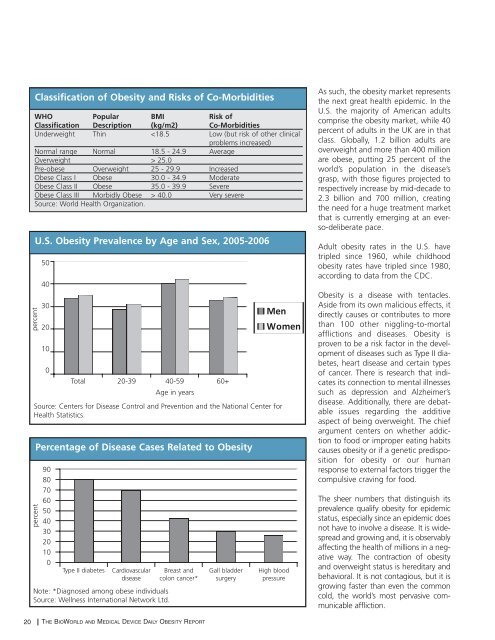You also want an ePaper? Increase the reach of your titles
YUMPU automatically turns print PDFs into web optimized ePapers that Google loves.
20<br />
Classification of Obesity and Risks of Co-Morbidities<br />
WHO Popular BMI Risk of<br />
Classification Description (kg/m2) Co-Morbidities<br />
Underweight Thin 25.0<br />
Pre-obese Overweight 25 - 29.9 Increased<br />
Obese Class I Obese 30.0 - 34.9 Moderate<br />
Obese Class II Obese 35.0 - 39.9 Severe<br />
Obese Class III Morbidly Obese > 40.0 Very severe<br />
Source: World Health Organization.<br />
percent<br />
U.S. Obesity Prevalence by Age and Sex, 2005-2006<br />
50<br />
40<br />
30<br />
20<br />
10<br />
0<br />
THE BIOWORLD AND MEDICAL DEVICE DAILY OBESITY REPORT<br />
Men<br />
Women<br />
Total 20-39 40-59<br />
Age in years<br />
60+<br />
Source: Centers for Disease Control and Prevention and the National Center for<br />
Health Statistics.<br />
percent<br />
Percentage of Disease Cases Related to Obesity<br />
90<br />
80<br />
70<br />
60<br />
50<br />
40<br />
30<br />
20<br />
10<br />
0<br />
Type II diabetes Cardiovascular<br />
disease<br />
Note: *Diagnosed among obese individuals<br />
Source: Wellness International Network Ltd.<br />
Breast and<br />
colon cancer*<br />
Gall bladder<br />
surgery<br />
High blood<br />
pressure<br />
As such, the obesity market represents<br />
the next great health epidemic. In the<br />
U.S. the majority of American adults<br />
comprise the obesity market, while 40<br />
percent of adults in the UK are in that<br />
class. Globally, 1.2 billion adults are<br />
overweight and more than 400 million<br />
are obese, putting 25 percent of the<br />
world’s population in the disease’s<br />
grasp, with those figures projected to<br />
respectively increase by mid-decade to<br />
2.3 billion and 700 million, creating<br />
the need for a huge treatment market<br />
that is currently emerging at an everso-deliberate<br />
pace.<br />
Adult obesity rates in the U.S. have<br />
tripled since 1960, while childhood<br />
obesity rates have tripled since 1980,<br />
according to data from the CDC.<br />
Obesity is a disease with tentacles.<br />
Aside from its own malicious effects, it<br />
directly causes or contributes to more<br />
than 100 other niggling-to-mortal<br />
afflictions and diseases. Obesity is<br />
proven to be a risk factor in the development<br />
of diseases such as Type II diabetes,<br />
heart disease and certain types<br />
of cancer. There is research that indicates<br />
its connection to mental illnesses<br />
such as depression and Alzheimer’s<br />
disease. Additionally, there are debatable<br />
issues regarding the additive<br />
aspect of being overweight. The chief<br />
argument centers on whether addiction<br />
to food or improper eating habits<br />
causes obesity or if a genetic predisposition<br />
for obesity or our human<br />
response to external factors trigger the<br />
compulsive craving for food.<br />
The sheer numbers that distinguish its<br />
prevalence qualify obesity for epidemic<br />
status, especially since an epidemic does<br />
not have to involve a disease. It is widespread<br />
and growing and, it is observably<br />
affecting the health of millions in a negative<br />
way. The contraction of obesity<br />
and overweight status is hereditary and<br />
behavioral. It is not contagious, but it is<br />
growing faster than even the common<br />
cold, the world’s most pervasive communicable<br />
affliction.

















